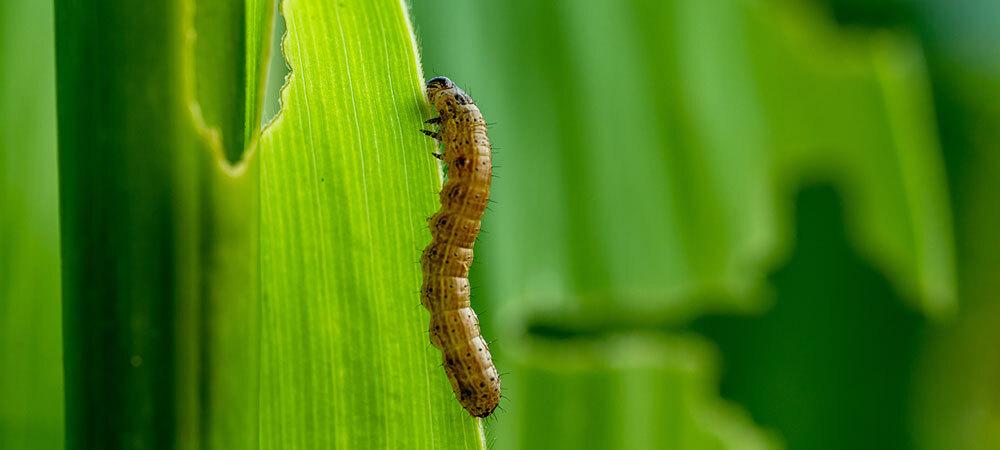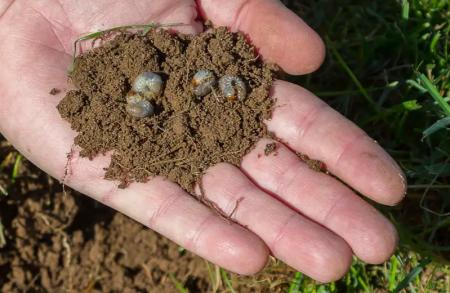
Armyworms, Grubs, and Mole Crickets: Georgia's Most Prevalent Autumn Lawn Pests
Georgia lawns face a few common invaders each autumn. These pests can quickly damage your carefully maintained turf, especially if left untreated. Understanding their behavior, recognizing the signs of infestation, and implementing effective control measures are crucial for Georgia homeowners to protect their lawns during the fall season.
What Are Georgia's Most Common Autumn Lawn Pests?

Autumn lawn pests in Georgia refer to insects that become particularly active and destructive during the fall season. The three most common culprits are:
- Armyworms: Caterpillars that feed voraciously on grass blades
- Grubs: Larvae of various beetle species that damage grass roots
- Mole Crickets (pictured to right): Burrowing insects that disrupt soil and grass roots
These pests thrive in Georgia's warm weather, so they take advantage of thick lawns before the cold of winter sets in. Their presence can lead to brown patches, thinning grass, and even large dead areas if not addressed promptly.
Key Benefits of Autumn Lawn Pest Control
Taking action against fall lawn pests isn’t just about keeping your yard looking nice. Effectively managing these pests offers several advantages for Georgia homeowners:
- Preserves Lawn Health - By preventing extensive damage, your grass maintains its vitality and appearance throughout the season and into spring.
- Saves Money - Early intervention can prevent the need for costly lawn renovation or replacement due to severe pest damage.
- Enhances Property Value - A well-maintained, pest-free lawn contributes to overall curb appeal and property aesthetics.
Distinguishing The Autumn Lawn Pests in Georgia
Armyworms
- Description: Small caterpillars that can quickly defoliate large areas of turf
- Best for: Identifying rapidly spreading lawn damage
- Pros and cons: Easy to spot but can cause extensive damage in a short time
Grubs
- Description: C-shaped larvae that feed on grass roots
- Best for: Detecting underlying lawn issues before visible damage occurs
- Pros and cons: Can be difficult to detect early but preventive treatments are effective
Mole Crickets
- Description: Burrowing insects that create tunnels and feed on grass roots
- Best for: Identifying soil disruption and irregular lawn texture
- Pros and cons: Distinctive damage pattern but can be challenging to control once established
How to Identify and Control Autumn Lawn Pest Infestations in Georgia
Protecting your lawn starts with knowing what to look for and taking timely action. Follow these steps:

- Conduct Regular Inspections - Walk your lawn weekly, looking for signs of damage or pest activity.
- Implement Cultural Controls - Maintain proper mowing height, watering, and fertilization practices to promote healthy grass that's more resistant to pests.
- Apply Targeted Treatments - Use appropriate insecticides or biological controls based on the specific pest identified. Always follow label instructions and local regulations.
Georgia-Specific Factors for Autumn Lawn Pest Control
Understanding local conditions and regulations can make all the difference in choosing the right approach. When dealing with lawn pests in Georgia, keep these considerations in mind:
- Climate Impact: Georgia's warm, humid autumns can extend pest activity periods, requiring vigilance well into the season.
- Grass Types: Common Georgia turf varieties like Bermuda, Zoysia, and Fescue may have different susceptibilities to specific pests.
- Local Regulations: Be aware of any restrictions on pesticide use in your area, particularly near water sources or in drought conditions.
Common Mistakes to Avoid in Autumn Lawn Pest Control
Making the right choices early on helps prevent bigger problems down the line. Steer clear of these pitfalls:
- Overuse of Pesticides: Excessive chemical use can harm beneficial insects and create resistant pest populations. Use integrated pest management approaches instead.
- Ignoring Early Warning Signs: Delaying action when you first notice pest activity can lead to more extensive and costly damage.
- Neglecting Proper Lawn Care: A stressed or unhealthy lawn is more susceptible to pest infestations. Maintain good cultural practices year-round.
Frequently Asked Questions
Q: How often should I treat my Georgia lawn for autumn pests?
A: Treatment frequency depends on pest pressure and lawn conditions. Generally, a preventive application in late summer followed by monitoring and spot treatments as needed is effective for most Georgia lawns.
Q: Are natural pest control methods effective against autumn lawn pests?
A: Some natural methods, such as beneficial nematodes for grub control, can be effective. However, severe infestations may require integrated approaches combining cultural, biological, and chemical controls for best results.
Q: Will autumn pest damage recover on its own?
A: Minor damage may recover with proper care, but significant infestations often require active intervention and potentially reseeding or sodding affected areas to restore lawn health.
Professional Lawn Care Services in Georgia
While some homeowners can manage autumn lawn pests, some situations may call for professional lawn pest control. The professionals at Legacy Lawn Care have extensive experience dealing with Georgia's specific lawn pest challenges. If you're unsure about pest identification, treatment options, or simply prefer to leave it to the experts, don't hesitate to reach out for a free estimate. Our team can provide tailored solutions to keep your lawn healthy and pest-free throughout the autumn season and beyond.
Last updated: 12/24/2025

